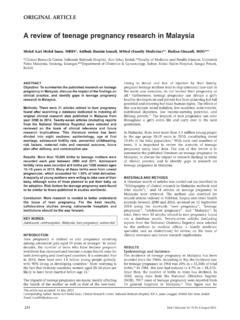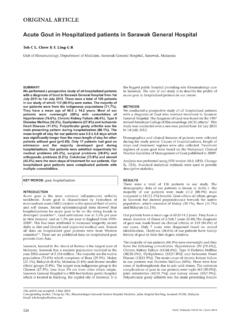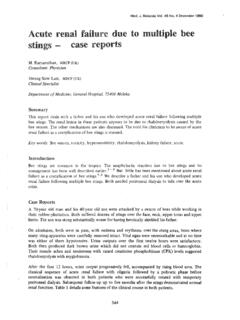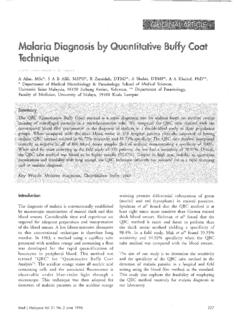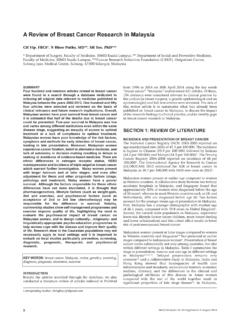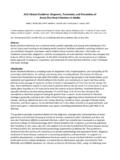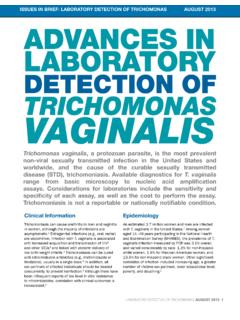Transcription of The Comparative Accuracy of Ultrasound and …
1 Med J Malaysia Vol 69 No 2 April 201479 SUMMARYAim: This study was performed to determine the Accuracy ofultrasound (USG) as compared to mammography (MMG) indetecting breast : This was a review of patients who had breastimaging and biopsy during an 18-month period. Details ofpatients who underwent breast biopsy were obtained fromthe department biopsy record books and imaging requestforms. Details of breast imaging findings and histology oflesions biopsied were obtained from the hospital IntegratedRadiology Information System (IRIS). Sensitivity, specificity,positive predictive value (PPV), negative predictive value(NPV) and Accuracy of USG and MMG were calculated withhistology as the gold standard.
2 Results: A total of 326 breast lesions were results revealed the presence of 74 breast cancersand 252 benign lesions. USG had a sensitivity of 82%,specificity of 84%, PPV = 60%, NPV = 94% and an accuracyof 84%. MMG had a sensitivity of 49%, specificity of 89%,PPV = 53%, NPV = 88% and an Accuracy of 81%. A total of161 lesions which were imaged with both modalities wereanalyzed to determine the significance in the differences insensitivity and specificity between USG and of USG (75%) was significantly higher thansensitivity of MMG (44%) (X21= , p= ). Specificity ofMMG (91%) was significantly higher than specificity of USG(79%) (X21= , p< ).
3 Compared with MMG, thesensitivity of USG was 50% (95% CI 10%-90%) higher inwomen aged less than 50 years (X21= , p= ) and27% (95% CI 19%-36%) higher in women aged 50 years andabove (X21= , p= ). Compared with MMG, thesensitivity of USG was 40% (95% CI 10%-70%) higher inwomen with dense breasts (X21= , p= ) and 27%(95% CI 9%-46%) higher in women with non-dense breasts(X21= , p= ). Conclusion: Accuracy of USG was higher compared withMMG. USG was more sensitive than MMG regardless of agegroup. However, MMG was more specific in those aged 50years and older. USG was more sensitive and MMG wasmore specific regardless of breast density.
4 In this study, 20%of breast cancers detected were occult on MMG and seenonly on WORDS:Breast cancer, Ultrasound , mammography, Accuracy , value of mammography (MMG) in the detection of earlybreast cancer has long been established. Several randomisedclinical trials have proven that screening MMG have reducedmortality rates from breast cancer by 15-22%1. But MMG hasits limitations. The false negative rate of MMG can be as highas 35%2. Possible causes of breast cancers missed on MMGinclude dense breast parenchyma obscuring a lesion,suboptimal positioning or technique, perception error,incorrect interpretation of a suspect finding, and subtlefeatures of malignancy2.
5 While most of these causes can beovercome with adequate training and experience, theproblem with dense breast parenchyma raises the need forother imaging methods such as breast Ultrasound (USG) tosupplement MMG. The majority of Malaysian women have dense breasts onMMG3, 4. This could lead to a higher likelihood of missing alesion. At our centre, USG is performed to further evaluatebreasts that are dense on MMG. Apart from this, our centreadvocates the use of USG to evaluate (i) an abnormalitydetected on MMG, (ii) breast(s) and bilateral axilla of womenwith personal history of breast cancer with normal MMG onfollow-up, (iii) breasts of women with family history of breastcancer with normal MMG on screening, (iv) breasts of womenwith normal first-time MMG, (v) a palpable lump in womenless than 35 years-old, (vi)
6 Clinically suspected breast study was conducted to determine the comparativeaccuracy of USG and MMG in breast imaging at our centreand whether this was affected by patient s age and breastdensity. This study also aimed to determine if USG haddetected breast cancers that were occult on study was approved by the hospital technical and ethicalcommittee. Patient informed consent was not required as thiswas a retrospective This study involved patients who had breast imaging andbiopsy at a tertiary hospital during an 18-month of patients (name, registration number, race, age andindication for imaging) who underwent breast biopsy wereobtained from the department biopsy record books andimaging request forms.
7 Details of breast imaging findingsThe Comparative Accuracy of Ultrasound andMammography in The Detection of Breast CancerK P Tan, MD (UKM)*, Z Mohamad Azlan, MD (UKM)*, M Y Choo, MD (UKM)*, M P Rumaisa , MD (UKM)*, M RSiti Aisyah Murni, MD (UKM)*, S Radhika, FRCR (UK)*, M I Nurismah, Dr Path (UKM)**, A Norlia, Dr Surg(UKM)**, M A Zulfiqar, Dr Rad (UKM)**Department of Radiology, **Department of Pathology, **Department of Surgery, Faculty of Medicine, Universiti KebangsaanMalaysia Medical Centre, Jalan Yaacob Latif, Bandar Tun Razak, 56000 Kuala LumpurORIGINAL ARTICLEThis article was accepted: 5 May 2014 Corresponding Author: M A Zulfiqar, Department of Radiology, Faculty of Medicine, Universiti Kebangsaan Malaysia Medical Centre, Jalan Yaacob Latif,Bandar Tun Razak, 56000 Kuala Lumpur Email.
8 Article80 Med J Malaysia Vol 69 No 2 April 2014and histology of lesions biopsied were obtained from thehospital Integrated Radiology Information System (IRIS). The USG and MMG findings were reported on a categoricalscale of 1-5 according to level of suspicion for malignancy (1:no abnormality; 2: benign finding; 3: indeterminate finding;4: suspicious lesion; 5: malignant lesion). Dense breast was defined as 50% and more of the breastcomprised of dense fibroglandular tissue on AssessmentThe USG assessment was with the Siemens Acuson S2000(Germany) diagnostic unit using a MHz were examined in a supine position and turnedslightly to the contralateral side with the ipsilateral upperlimb extended cephalad.
9 This position flattened the breastsymmetrically over the chest wall. The breasts were scannedin longitudinal, transverse and radial planes. Indications for breast USG included: to characterise a noduledetected on MMG, to assess breasts that were dense on MMG,to assess a palpable mass in patients aged less than 35 years,normal follow-up MMG in patients with previous history ofbreast cancer, normal 1st MMG, and in clinically suspectedbreast abscess. Characteristics of a breast nodule assessed onUSG included: margins, internal echoes, posterior echoes,depth-width ratio and compressibility.
10 Nodules were assigneda category according to level of suspicion for USG were performed by the radiologist-in-training. Theimages were then reviewed by the radiologist as a 2nd was repeated when there were discordant AssessmentTwo-view (cranial-caudal and medial-lateral oblique) MMGexaminations were performed using the Hologic LoradSelenia (United States) unit. Indications for MMG include:breast symptoms, previous breast cancer, hormonereplacement therapy, and request for of a breast nodule assessed on MMG included:shape, margin, density, presence of calcifications,architectural distortion, number of lesions, site of lesions andlymph nodes.
